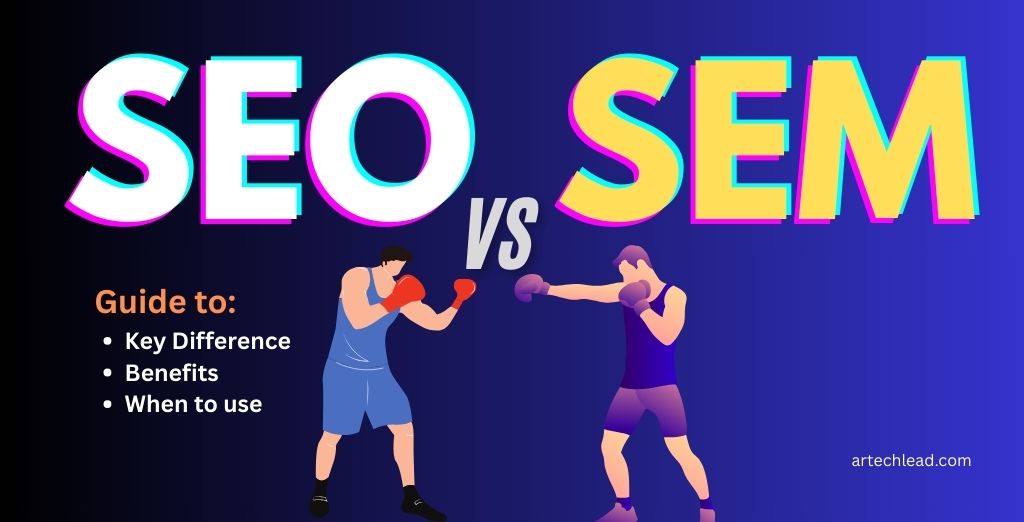SEO vs SEM: Key Differences, Benefits & When to Use Each
Such confusion with SEO and SEM is easily being experienced by newbies to digital marketing as well as seasoned marketers. While both strategies intend to increase the traffic directed to your website and boost visibility within search engine results pages (SERPs), they are different.
This deep delve guide will take you through what sets SEO vs SEM apart from one another, their respective advantages, and the best of the two for your specific business needs.
What is SEO (Search Engine Optimization)?
SEO is the work you do to boost your ranking results in organic search queries on search engines like Google or Bing. Unlike paid advertising, you aren’t paying for clicks but it does require time, effort, and know-how to make it successful.
Core Elements of SEO:
- On-Page SEO
- Keyword optimization.
- High-quality, valuable content.
- Optimized title tags, headers, and meta descriptions.
- URL structure and internal linking.
- Keyword optimization.
- Off-Page SEO
- Building backlinks from authoritative websites
- Social sharing signals
- Online brand mentions
- Building backlinks from authoritative websites
- Technical SEO
- Website speed and performance
- Mobile-friendliness
- XML sitemaps and robots.txt
- Secure site (HTTPS)
- Website speed and performance
- Local SEO
- Google Business Profile optimization
- Local citations and reviews
- Targeting geo-specific keywords
- Google Business Profile optimization
SEO is best for:
- Long-term growth.
- Building authority and trust.
- Sustainable traffic without recurring ad spend.
What is SEM ( Search Engine marketing)?
SEM is much broader than just paid advertising on the search engines. Most of the time, it refers to platforms like Google Ads (formerly AdWords) or Bing Ads and similar PPC (Pay-Per-Click) advertising services.
Components of SEM:
- Search Ads (PPC).
- Text advertisements included above organic results.
- targeting keywords, location, device, etc.
- Charge per the click.
2. Display advertisements
- Visual advertisements placed on partner websites
- Targeted by audience demographic or behavior
3. Shopping ads
- Product-specific ads in search results that include images and pricing
- Best suited for e-commerce stores
4. Remarketing
- Ads targeting users who have visited your site
SEM is best at:
- Quick and short-term traffic boosts
- Testing new product or market initiatives
- Increasing visibility against a high-competitive keyword
SEO vs SEM: A Side-by-Side Comparison
Feature | SEO | SEM |
Cost | Free clicks, time-intensive | Pay-per-click (PPC) |
Speed of Results | Slower (months to see results) | Immediate visibility and traffic |
Sustainability | Long-term traffic source | Short-term unless continuously funded |
Trust Factor | High (organic listings = credibility) | Lower (marked as ads) |
Click-Through Rate (CTR) | Often higher for top organic results | Can be high, but varies by ad quality |
Targeting Options | Keyword and content relevance | Keywords + audience, location, device |
Control over Results | Limited (subject to algorithm changes) | Full control over placement, timing |
Learning Curve | Medium to high | Medium (platform-dependent) |
When to Use SEO vs SEM
The following is the summary of the conditions under which one might need to use a particular strategy:
Use SEO When:
- You want to build sustainable, long-term visibility.
- You have time to invest in content and technical optimization.
- You’re in a niche with low-to-medium competition.
- You want to increase brand authority and trust.
Use SEM When:
- You need immediate traffic or leads.
- You’re promoting a limited-time offer or product launch.
- You’re targeting high-competition keywords.
- You have a budget for ads and want to test performance quickly.
How SEO and SEM Can Work Together
Many successful businesses combine SEO and SEM
to maximize results. Here’s how:
Benefits of a Combined Strategy:
- Faster Keyword Data: Use SEM to test keyword performance, then optimize your SEO based on the results.
- Increased SERP Real Estate: Occupy both ad space and organic listings to dominate search results.
- Retargeting SEO Visitors: Drive traffic with SEO and convert it with SEM remarketing ads.
- Balancing Risk: SEO takes time; SEM fills the gap with instant visibility.
Example:
An e-commerce business could:
- Use SEO to target long-tail informational keywords (e.g., “how to choose running shoes”)
- Use SEM to target transactional keywords (e.g., “buy Nike running shoes”).
Tools to Manage SEO and SEM
Running and measuring both strategies effectively could only be done through having the best tools
SEO Tools:
- Google Search Console – Presenting organic performance and technical insights.
- Ahrefs / SEMrush / Moz – Keyword Tracking, backlinks reviewing.
- Screaming Frog – Technical SEO audits.
- Yoast SEO (WordPress) – On-page improvement plugin.
SEM Tools:
- Google Ads / Bing Ads – PPC management of advertisement.
- Google Keyword Planner – Keyword volume and competition.
- Google Analytics – Measure Campaign Performance and Conversions.
Which Strategy is Right for you?
It is not an all or none answer to SEO vs SEM. Your most ideal mechanism would hence depend on:
- Goals: (brand awareness vs lead generation)
- Budget: (time vs money)
- Time frame: (immediate vs long-term).
- Industry competition.
However, in many cases, a mixed approach wins: get some fast hits with SEM and build long-term authority with SEO.
Final Words
SEO vs SEM are not contrasting but complement each other. SEO is more focused on building a strong foundation for enduring success while SEM manages to reel in one-off opportunities. Understanding the differences, strengths, and use cases between these two will increase your marketing acumen and potential maximization of the digital world.
Capable of wielding both strategies competently, the endurance and maximum visibility of your business are guaranteed, while driving qualified traffic further into its internal structures and thus sustainably feeding revenue.
Let us know if you found this article helpful, and share your SEO and SEM experiences and tips in comments!
Author







